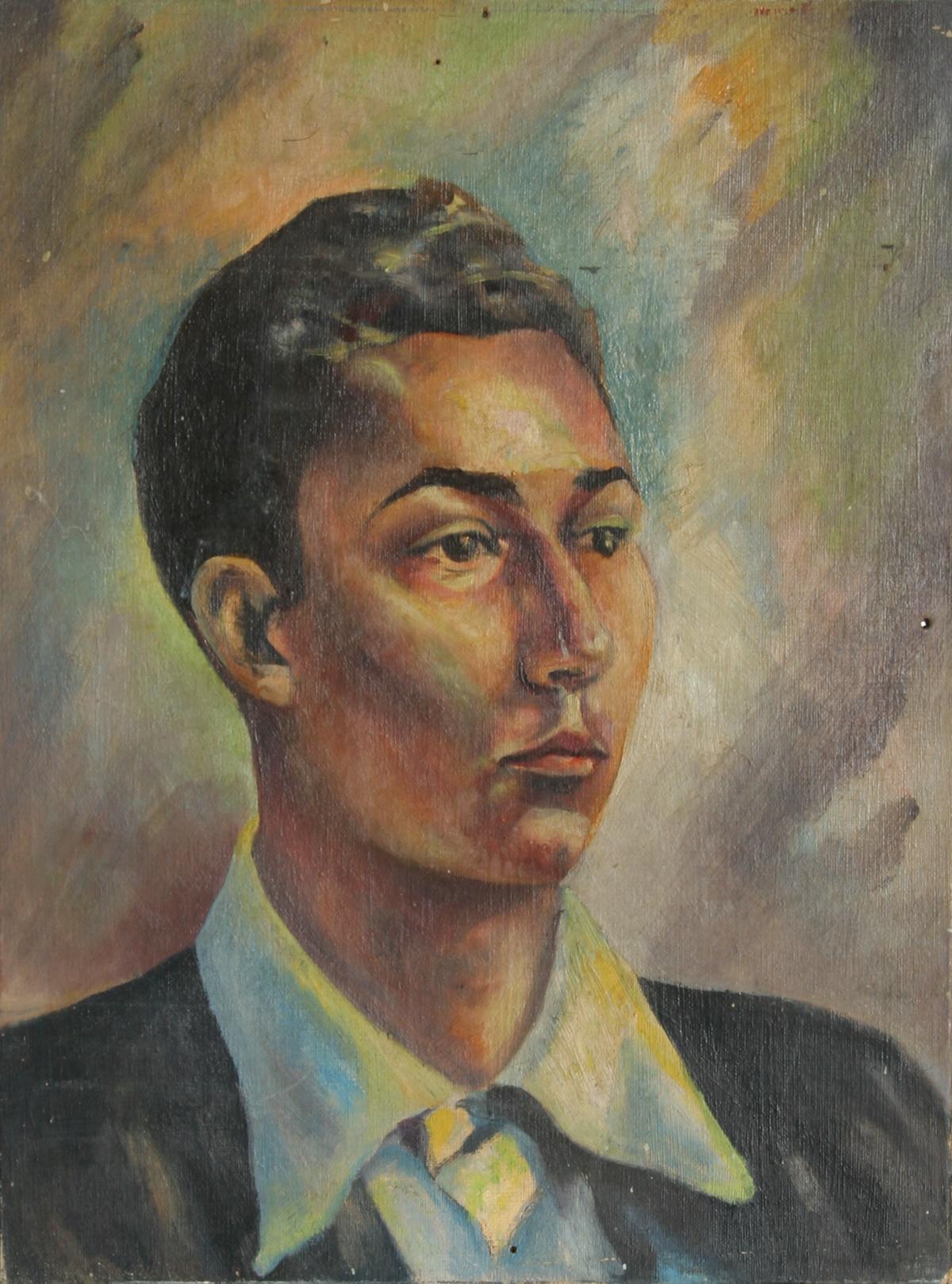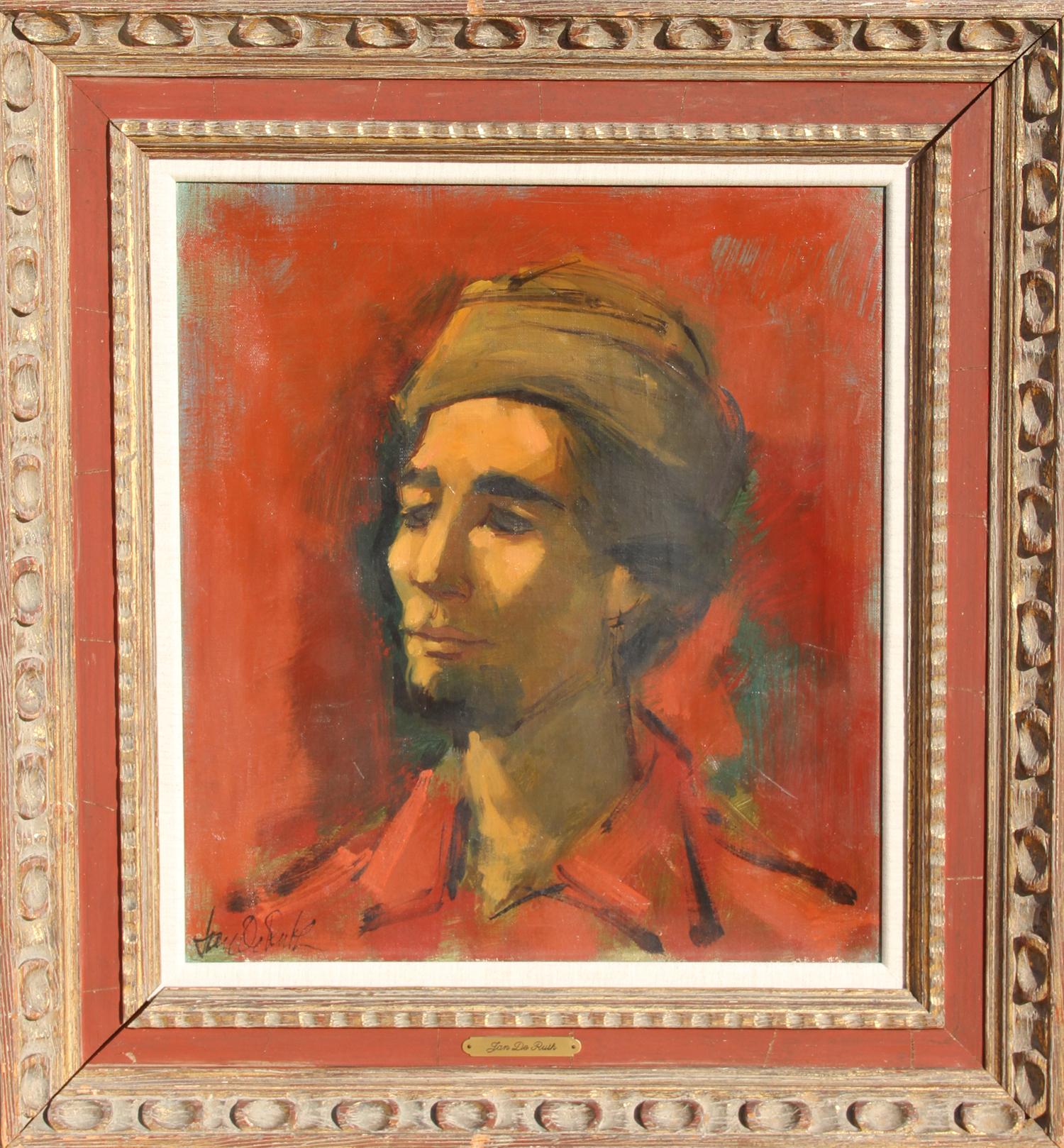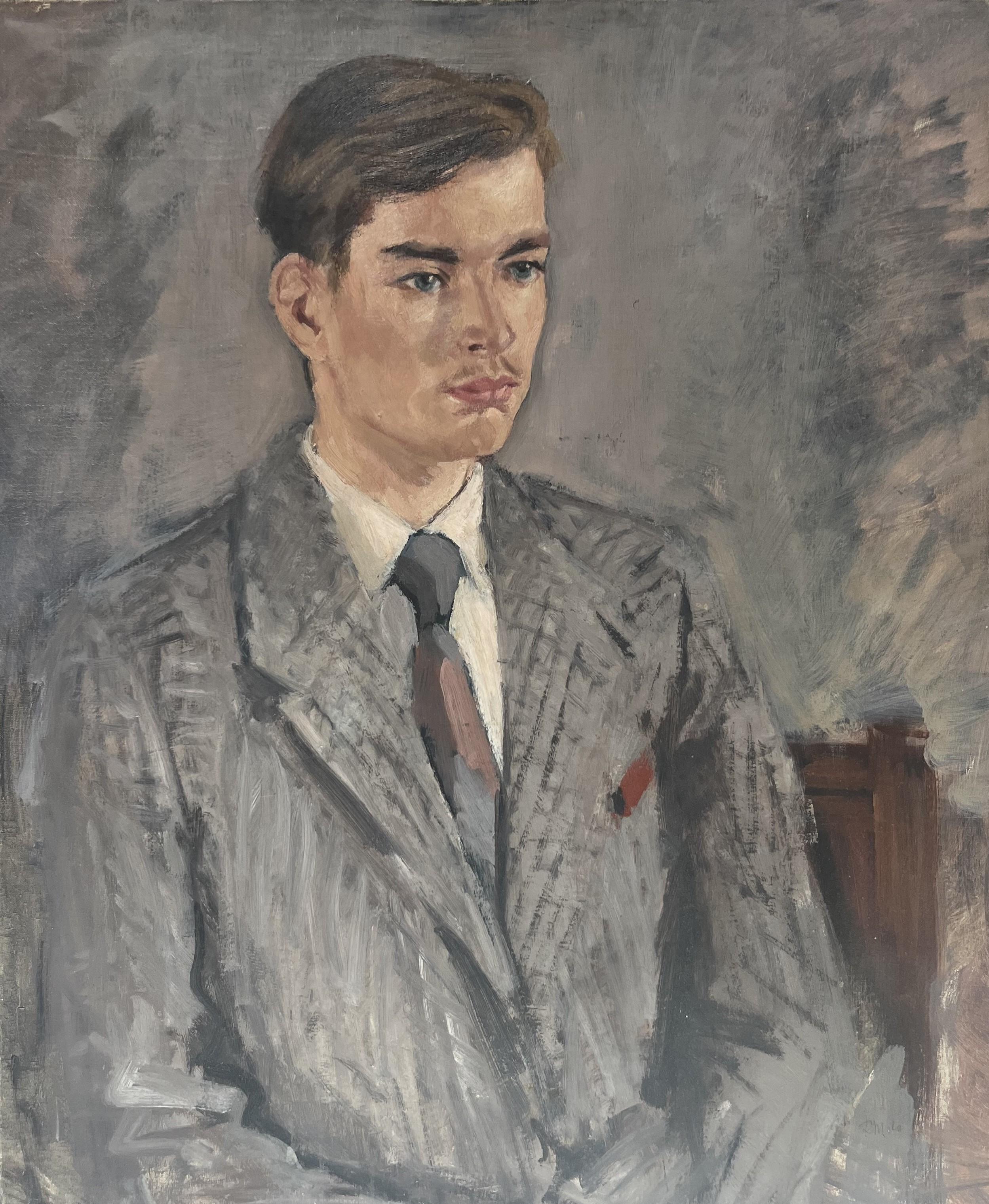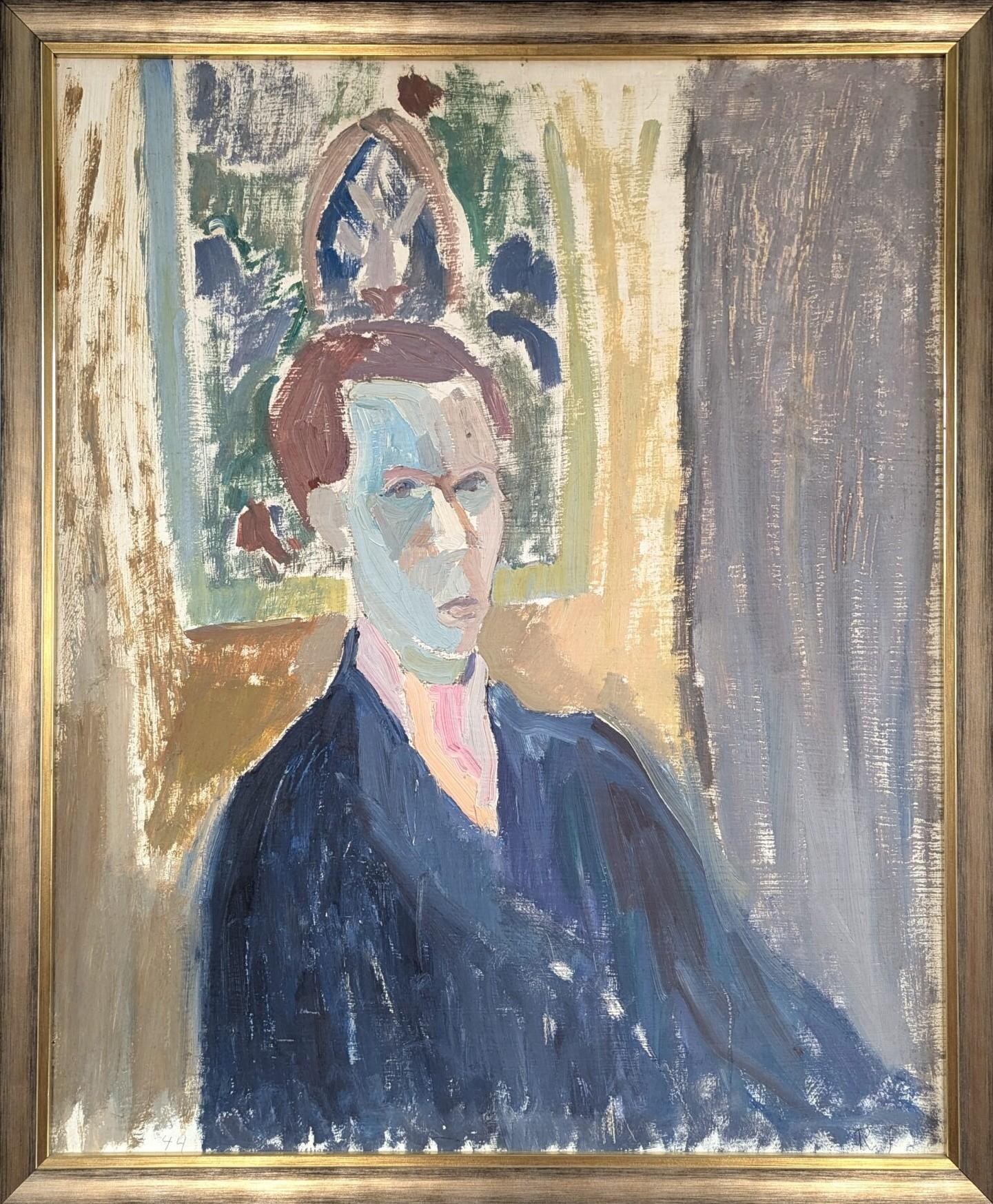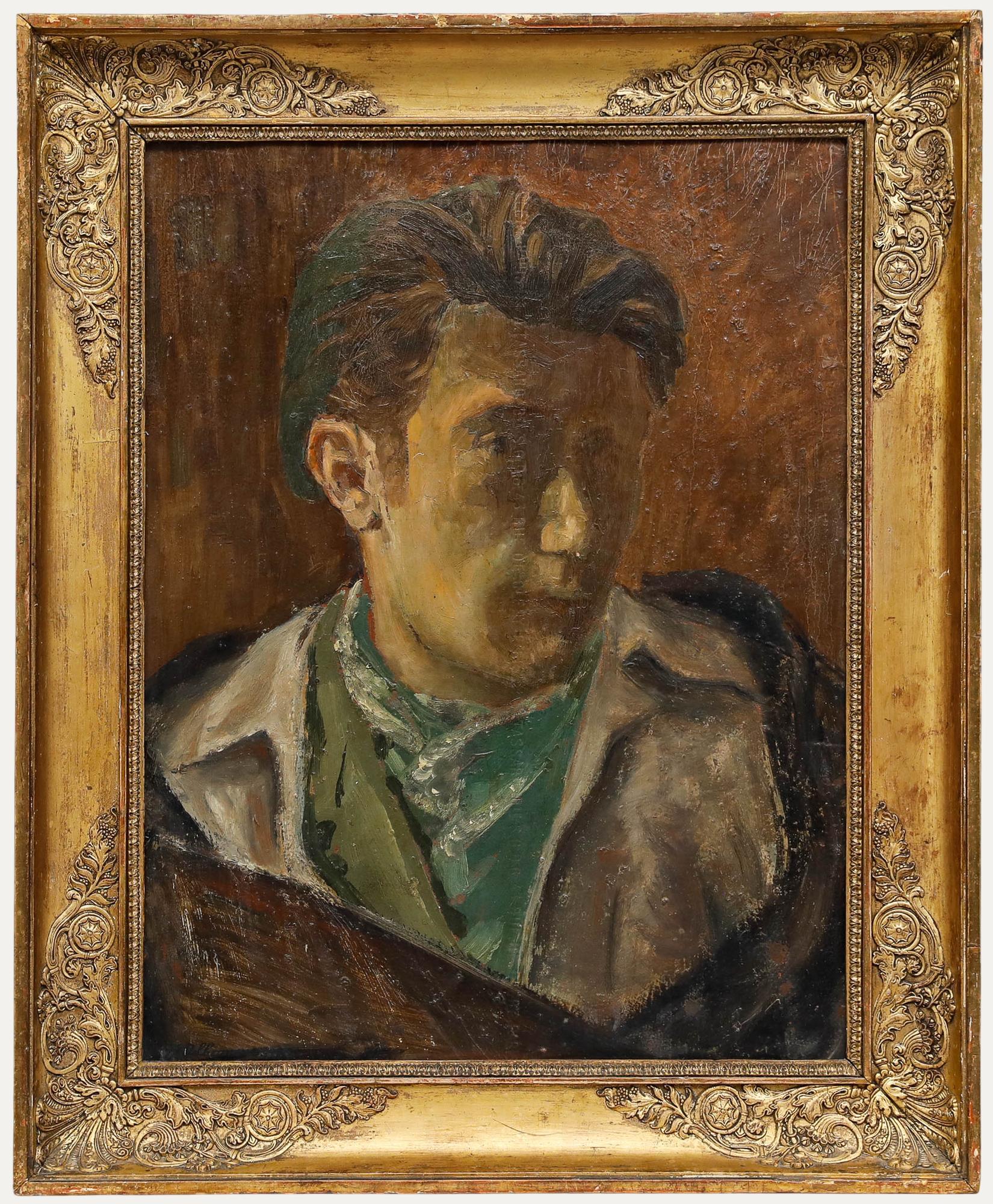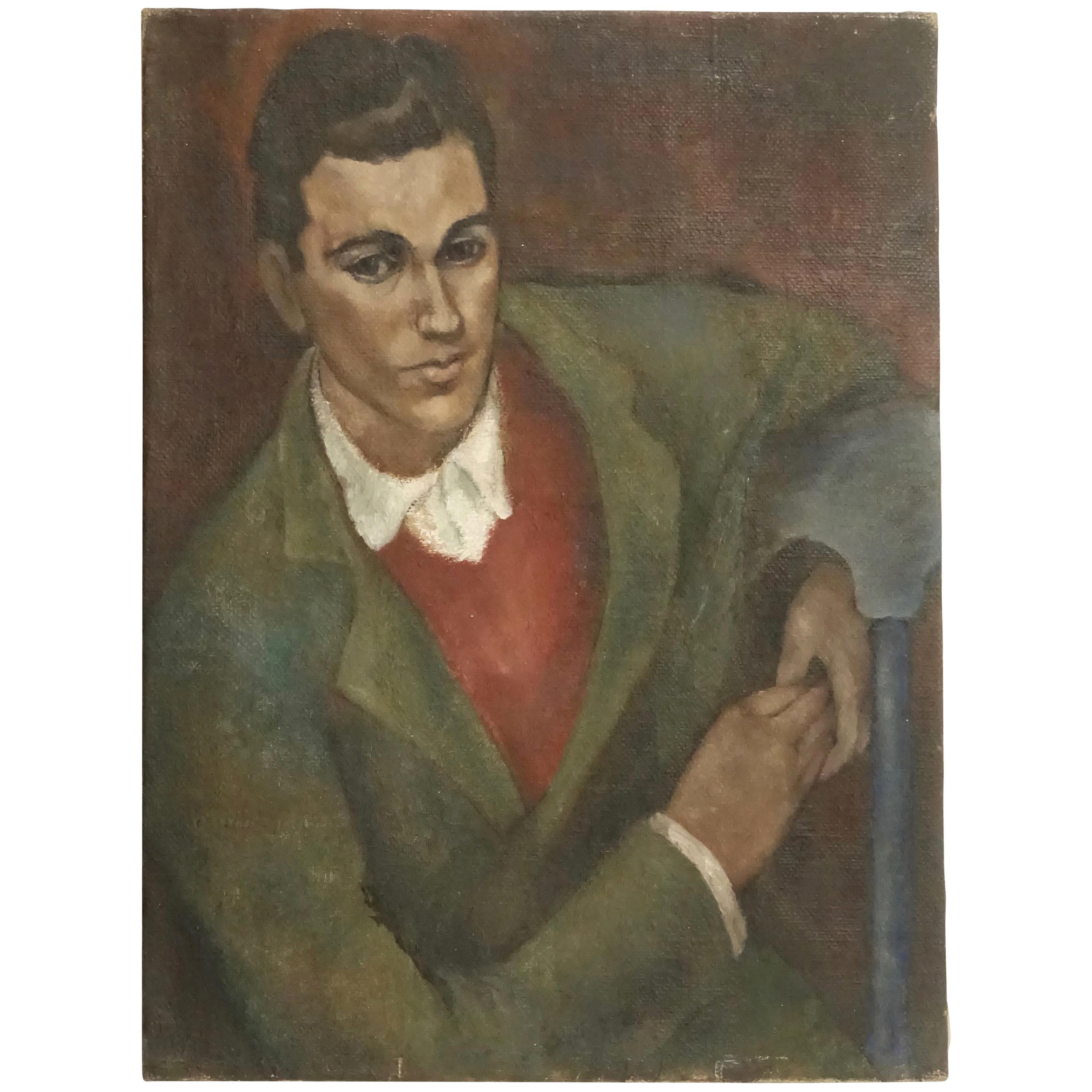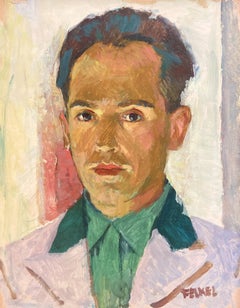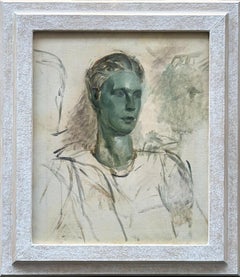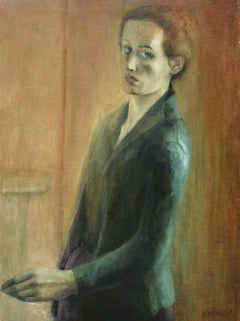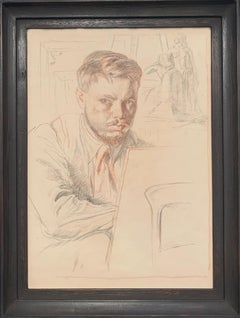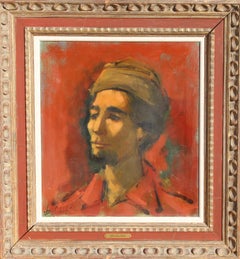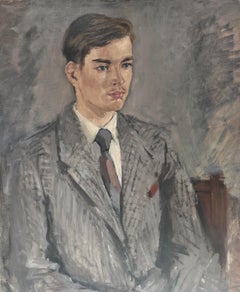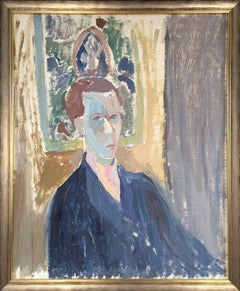Items Similar to Portrait of Stanley Bate, 20th Century Musician
Want more images or videos?
Request additional images or videos from the seller
1 of 7
Clara KlinghofferPortrait of Stanley Bate, 20th Century Musician
$20,667.66
£15,000
€17,751.14
CA$28,475.05
A$31,725.23
CHF 16,562.07
MX$385,186.57
NOK 208,174.43
SEK 196,775.41
DKK 132,510.14
About the Item
Oil on canvas
Image size: 24 x 29 inches (61 x 73.5 cm)
Contemporary style gilt frame
Provenance
From the estate of the artist, Clara Klinghoffer
This portrait is by an artist who propelled rapidly into the limelight after her first solo exhibition in 1920, at the age of 19, with the Daily Graphic naming her as the 'Girl Who Draws Like Raphael'. Yet today Clara Klinghoffer's name is little know.
Klinghoffer's early success resulted in numerous portrait commissions, including this one of the English composer Stanley Bate. The bold use of colour and naive execution of this portrait clearly reveals the modernist influence of fellow Jewish artists such as Bernard Meninsky, Jacob Kramer and Mark Gertler. Bate is seen in a natural pose, cigarette in hand while he sits at his piano. The delicate brushstrokes that make up the subject and background are typical of Klinghoffer's style and demonstrate her noted sensitivity and skill as a portraitist.
- Creator:Clara Klinghoffer (1900 - 1970, British)
- Dimensions:Height: 29 in (73.66 cm)Width: 24 in (60.96 cm)
- More Editions & Sizes:1 of 1Price: $20,668
- Medium:
- Movement & Style:
- Period:
- Condition:
- Gallery Location:London, GB
- Reference Number:1stDibs: LU52410975432
About the Seller
5.0
Vetted Professional Seller
Every seller passes strict standards for authenticity and reliability
Established in 2007
1stDibs seller since 2014
82 sales on 1stDibs
Typical response time: 3 hours
- ShippingRetrieving quote...Shipping from: London, United Kingdom
- Return Policy
Authenticity Guarantee
In the unlikely event there’s an issue with an item’s authenticity, contact us within 1 year for a full refund. DetailsMoney-Back Guarantee
If your item is not as described, is damaged in transit, or does not arrive, contact us within 7 days for a full refund. Details24-Hour Cancellation
You have a 24-hour grace period in which to reconsider your purchase, with no questions asked.Vetted Professional Sellers
Our world-class sellers must adhere to strict standards for service and quality, maintaining the integrity of our listings.Price-Match Guarantee
If you find that a seller listed the same item for a lower price elsewhere, we’ll match it.Trusted Global Delivery
Our best-in-class carrier network provides specialized shipping options worldwide, including custom delivery.More From This Seller
View AllSelf Portrait, 20th Century Jewish Artist Oil Painting
By Carl Felkel
Located in London, GB
Oil on board, signed bottom right
Image size: 13 1/2 x 17 inches (34.25 x 43 cm)
Contemporary frame
The Artist
Painter Carl Friedrich Felkel was born in 1896, in Stockerau, near Vienna, Austria-Hungary (now Austria) and was probably of Jewish descent. He initially studied under Walter Thor...
Category
Mid-20th Century Modern Portrait Paintings
Materials
Oil, Board
Portrait of a Young Man Oil Painting Celebrated 20th Century Artist
By Oliver Messel
Located in London, GB
Oliver Messel
1904 - 1978
Portrait of a Young Man
Oil on canvas, signed and dated 'Oliver Messel 1930' (on the stretcher)
Image size: 30 x 25 inches (76.2 x 63.4 cm)
Original frame
Oliver Messel was born to Leonard and Maud Messel, née Sambourne, on the 13 January 1904 and was the youngest of three children. The family moved to Nymans, the Messel family home in Sussex, from nearby Balcombe in 1915. The house remained in the family until 1953 when it was bequeathed to the National Trust, following a fire in 1947 which destroyed a large portion of the house.
The Messels originated from a line of German Jewish bankers on Leonard’s side, however, both family lines boast a number of artistic influences, including Maud’s father. Maud was brought up at 18 Stafford Terrace, Kensington (now known as the Linley Sambourne House Museum), amongst collections of antique porcelain and eighteenth-century furniture, and with a host of artistic visitors such as Henry Irving and Oscar Wilde.
Oliver’s own upbringing appears to be influenced by his mother's, as the Messel family were also affiliated with artists and writers and were keen collectors of art, filling their home with textiles, paintings and collections of European and Asian fans from travels abroad. It was amongst such treasures that Oliver, Anne and Linley spent their childhood, in addition to the beauty of Nyman’s extensive gardens.
Oliver was schooled at Eton but rather than going up to university was encouraged by family friends, gallery owner Archie Propert and painter and sculptor Glyn Philpot, to attend art school. In 1922 he enrolled at the Slade School of Fine Art in London, where he studied under Henry Tonks. Here, he met the artist Rex Whistler with whom he remained firm friends until Whistler’s death in WW2.
Upon leaving the Slade in 1924 Oliver was apprenticed to the studio of portrait artist John Wells, where he learnt various Old Master painting techniques, and met artists such as Jacob Epstein, Augustus John and William Orpen.
Whilst at the Slade Oliver developed his interest in Papier Mâché masks, a pastime popular amongst many art students at the time. Whilst apprenticed to artist John Wells several of Oliver’s masks were exhibited at the Claridge Gallery, London, alongside pieces by Whistler and other young artists. These were seen by Serge Diaghilev, director of the Ballet Russes, and Charles B. Cochran, a theatrical producer, both of whom made Oliver offers of work.
His first job in the theatre was creating masks for the Ballets Russes’ Zéphyr et Flore, 1925, designed by the French artist Georges Braque, followed by numerous musical revues for Cochran, including Wake Up and Dream!, 1929, with music by Cole Porter. It was during these revues, working with Porter and Noel Coward, that Oliver also began to design headdresses and costumes. In 1932 he was rewarded with his first full commission to design both costume and sets for Helen!, directed by Max Reinhardt. The production design is still celebrated today for its innovative approach and ground-breaking ‘white on white’ aesthetic, which referenced ‘Greek temples, Rococo drapes, Baroque colonnades and Louis XIV carousels’.
The success of Helen! led to further offers within the theatre including Reinhardt’s version of A Midsummer Night’s Dream at the Old Vic in 1937, starring Vivien Leigh as Titania and Robert Helpmann as Oberon, the Jean Cocteau play The Infernal Machine in 1940, and Christopher Fry’s translation of Jean Anouilh’s Ring Round the Moon, 1950.
One of Oliver’s best-known productions during this period was the Russian ballet The Sleeping Beauty, performed by Sadler’s Wells Ballet in 1946 at the Royal Opera House, Covent Garden. Encompassing over 200 costumes and four set changes, Oliver’s romantic designs were celebrated for bringing colour back to post-war London, and variations on his designs are still used today. Additional designs for the ballet included Comus in 1940, for which he was released from war duties, and Homage to the Queen, choreographed by Frederick Ashton and performed in 1953 for the Queen’s coronation.
His first opera was in 1940 for Mozart’s Die Zauberflöte at the Royal Opera House, followed by a series of productions at the newly founded Glyndebourne Opera House in Sussex, for which Oliver also designed the proscenium arch. He triumphed in 1956 designing a season of four different productions for their Mozart bicentennial, also providing illustrations for the programme covers.
His popularity also spread beyond theatre to film, were he worked on over eight different feature films including Romeo and Juliet, 1936, directed by George Cukor. During a three-month research trip to Italy Oliver collected over 3,000 reference images including postcards of artwork by Piero della Francesca, Giovanni Bellini and Leonardo da Vinci, along with prints and photographs of textiles and architectural features.
A production of Gabriel Pascal’s Caesar and Cleopatra, 1946, starring Vivien Leigh and Claude Rains, was celebrated for Oliver’s ability to recreate the opulence and luxury of ancient Egypt under the constraints of wartime rationing. Such was his skill that Vivien Leigh in a letter to Oliver declared that “I have of course told Pascal that nobody in the world must do the costumes except you.” He was later nominated for an Academy Award for his work on his final film Suddenly, Last Summer, 1959; an adaptation of Tennessee Williams’ American Southern Gothic mystery.
Having started his artistic career as a portrait apprentice, capturing the faces of family and friends, Oliver continued to develop this practice until the end of his life. His style is said to have been influenced by Glyn Philpot, the Messel’s family friend who encouraged Oliver from an early age in his pursuit of art and design. His most prolific period came in the 1950s during which he produced over 50 portraits, which were shown in exhibitions in New York, London and Barbados.
The exhibitions included both well-known faces and anonymous sitters captured on Oliver’s travels, and a number of these works have entered private collections. He continued to paint after moving to the Caribbean in 1966, capturing society figures and the rich and famous including fashion designer Carolina Herrera and Bianca Jagger. His style remained unchanged throughout his career, using the same soft painterly strokes and subtle palette as in his theatre designs.
By far his greatest contribution in addition to theatre and film was Oliver’s interior and architectural designs.
Another, much celebrated commission included Rayne shoe shop in Old Bond Street, where he created jewel-like interiors using the same practice of scaled models as his set designs. Other notable interior designs include those for Norwich and Bath Assembly Rooms, Flaxley Abbey in Gloucestershire, Rosehill Theatre in Cumbria and the Reader’s Digest offices in Paris.
However, upon moving to Barbados in 1966, Oliver embraced a new career envisioning architectural concepts for private houses, hotels and public buildings, utilising his experience with interior design to furnish them with bespoke items of furniture and textiles. His first project was Maddox, the deserted eighteenth-century plantation house bought by himself and his partner Vagn Riis-Hansen in 1964. The existing building and gardens were remodelled to Oliver’s designs embracing an inherent theatricality with views out to sea. These were framed by terraces and verandas which extended out from the living rooms creating what is often referred to as a Caribbean style of ‘indoor-outdoor’ living. For the woodwork he used a shade of green that is now known as ‘Messel green’ and often associated with the island of Barbados.
Oliver was born into a wealthy family; he travelled extensively and was exposed to art and culture from a young age. A privileged youth, his name is often mentioned amongst the ‘Bright Young Things’, for whom costume parties at country houses and jaunts to Europe on a whim became a thing of fable. This informal group included people such as Cecil Beaton (a life-long friend whom Oliver first met at Eton), Lord Berners, Noel Coward, John Betjeman, Harold Acton, Nancy Mitford, Edith Sitwell, Stephen Tennant...
Category
20th Century Modern Portrait Paintings
Materials
Canvas, Oil
Self Portrait, Mid-20th Century Oil
Located in London, GB
Sheila Holland
1932-2002
Self Portrait
Oil on canvas, signed lower right
Image size: 30 x 22 inches
This is a wonderfully dynamic self portrait by the female artist Shelia Holland. ...
Category
Mid-20th Century Portrait Paintings
Materials
Oil
Bernard, Self Portrait
Located in London, GB
English School
Bernard, Self Portrait
1950s
Pencil and sepia chalk on paper
Image size: 9 1/2 x 13 1/2 inches (24 x 34.3 cm)
Handmade contemporary frame
This imaginative self-portra...
Category
1950s Portrait Drawings and Watercolors
Materials
Paper, Chalk, Pencil
Portrait of a Young Girl Oil Painting 20th Century
Located in London, GB
Circle of Thomas Derrick
British 1885 - 1954
Oil on panel
Image size: 21 1/2 x 14 inches (55 x 36 cm)
Hand made frame
Category
1950s Portrait Paintings
Materials
Oil
Portrait of a Man
By William Dring
Located in London, GB
William Dring
1904-1990
Ink on paper
Image size: 15 1/4 x 11 1/4 inches (38.9 x 28.5cm)
The artwork portrays a man in profile, meticulously rendered in ink on paper. Dring pays close attention to the contours of the skin and hair. The intricate facial details prompt viewers to contemplate themes of identity and expression, while the minimalistic background underscores the figure’s separation from its surroundings.
William Dring
Dring was born with the forenames Dennis William, but was known colloquially as John. He was the brother of the artist James Dring. He married the painter Grace Elizabeth...
Category
20th Century Portrait Drawings and Watercolors
Materials
Paper, Ink
You May Also Like
Portrait of William James, 1949 Oil on Board by John F. Leonard
Located in Long Island City, NY
Portrait of William James (39)
John F. Leonard
American (1921–1987)
Date: 1949
Oil on Board
Size: 16 in. x 12 in. (40.64 cm x 30.48 cm)
Category
1940s American Modern Portrait Paintings
Materials
Oil, Board
Portrait of the Artist as a Young Man, Modern Oil Painting by Jan de Ruth
By Jan De Ruth
Located in Long Island City, NY
Artist: Jan De Ruth, Czech (1922 - 1991)
Title: Portrait of the Artist as a Young Man
Year: circa 1964
Medium: Oil on Canvas, signed l.l.
Size: 20 in. x 18 in. (50.8 cm x 45.72 cm)
F...
Category
1960s Modern Portrait Paintings
Materials
Oil
René Mels (1909-1977) Portrait of a young man, oil on canvas signed
Located in Paris, FR
René Mels (1909-1977)
Portrait of a young man,
signed lower right
oil on canvas
73 x 60 cm
Framed : 77.5 x 64.5
This impressive portrait is obviously tou...
Category
1940s Modern Portrait Paintings
Materials
Oil
1944 Vintage Mid Century Modern Swedish Figurative Portrait Oil Painting - Oscar
Located in Bristol, GB
OSCAR
Oil on board
Size: 65.5 x 54.5 cm (including frame)
A striking and emotive mid-century figurative portrait composition that is characterised by expressive brushwork and a rich...
Category
Mid-20th Century Modern Portrait Paintings
Materials
Oil, Board
Georges Eugene Delhomme (1904-1989) - 20th Century Oil, Self Portrait
Located in Corsham, GB
This intimate self portrait depicts the artist in contemplative three-quarter view, rendered with loose, expressive brushwork that captures both the subject's pensive mood.
Signed t...
Category
20th Century Portrait Paintings
Materials
Oil
WPA Style Portrait Painting of a Gentleman, American, 1930s-1940s
Located in San Francisco, CA
Portrait painting of Walter Levin, oil on canvas, unframed. Signed Haughton College Bickerton in upper right corner, and having the original gallery label on the back. California Bay...
Category
Mid-20th Century American Paintings
Materials
Canvas
More Ways To Browse
Jewish Portrait
Portrait Of A Little Girl
Portrait Naive Paintings
Mark Gertler
Portrait Neck
Lord Portrait
Belgium Oil Painting Portrait
Unknown 19th Century Oil Portrait
Portrait Painting Boy Framed
18th Century British Paintings
Prince Charles
Antique Portrait Light
Portrait Oval Frame
18th Century French Portraits
19th Century Portrait Of A Lady
Oval Portrait Paintings
Oil Portrait Sisters
Painting Of Two Girls Portrait
